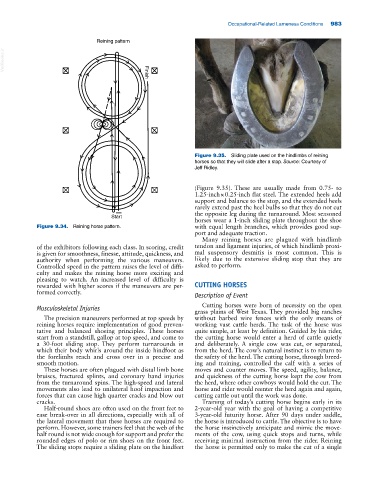Page 1017 - Adams and Stashak's Lameness in Horses, 7th Edition
P. 1017
Occupational‐Related Lameness Conditions 983
Reining pattern
VetBooks.ir Finish
Figure 9.35. Sliding plate used on the hindlimbs of reining
horses so that they will slide after a stop. Source: Courtesy of
Jeff Ridley.
(Figure 9.35). These are usually made from 0.75‐ to
1.25‐inch × 0.25‐inch flat steel. The extended heels add
support and balance to the stop, and the extended heels
rarely extend past the heel bulbs so that they do not cut
the opposite leg during the turnaround. Most seasoned
Start
horses wear a 1‐inch sliding plate throughout the shoe
Figure 9.34. Reining horse pattern. with equal length branches, which provides good sup
port and adequate traction.
Many reining horses are plagued with hindlimb
of the exhibitors following each class. In scoring, credit tendon and ligament injuries, of which hindlimb proxi
is given for smoothness, finesse, attitude, quickness, and mal suspensory desmitis is most common. This is
authority when performing the various maneuvers. likely due to the extensive sliding stop that they are
Controlled speed in the pattern raises the level of diffi asked to perform.
culty and makes the reining horse more exciting and
pleasing to watch. An increased level of difficulty is
rewarded with higher scores if the maneuvers are per CUTTING HORSES
formed correctly. Description of Event
Musculoskeletal Injuries Cutting horses were born of necessity on the open
grass plains of West Texas. They provided big ranches
The precision maneuvers performed at top speeds by without barbed wire fences with the only means of
reining horses require implementation of good preven working vast cattle herds. The task of the horse was
tative and balanced shoeing principles. These horses quite simple, at least by definition. Guided by his rider,
start from a standstill, gallop at top speed, and come to the cutting horse would enter a herd of cattle quietly
a 30‐foot sliding stop. They perform turnarounds in and deliberately. A single cow was cut, or separated,
which their body whirls around the inside hindfoot as from the herd. The cow’s natural instinct is to return to
the forelimbs reach and cross over in a precise and the safety of the herd. The cutting horse, through breed
smooth motion. ing and training, controlled the calf with a series of
These horses are often plagued with distal limb bone moves and counter moves. The speed, agility, balance,
bruises, fractured splints, and coronary band injuries and quickness of the cutting horse kept the cow from
from the turnaround spins. The high‐speed and lateral the herd, where other cowboys would hold the cut. The
movements also lead to unilateral hoof impaction and horse and rider would reenter the herd again and again,
forces that can cause high quarter cracks and blow out cutting cattle out until the work was done.
cracks. Training of today’s cutting horse begins early in its
Half‐round shoes are often used on the front feet to 2‐year‐old year with the goal of having a competitive
ease break‐over in all directions, especially with all of 3‐year‐old futurity horse. After 90 days under saddle,
the lateral movement that these horses are required to the horse is introduced to cattle. The objective is to have
perform. However, some trainers feel that the web of the the horse instinctively anticipate and mimic the move
half round is not wide enough for support and prefer the ments of the cow, using quick stops and turns, while
rounded edges of polo or rim shoes on the front feet. receiving minimal instruction from the rider. Reining
The sliding stops require a sliding plate on the hindfeet the horse is permitted only to make the cut of a single

